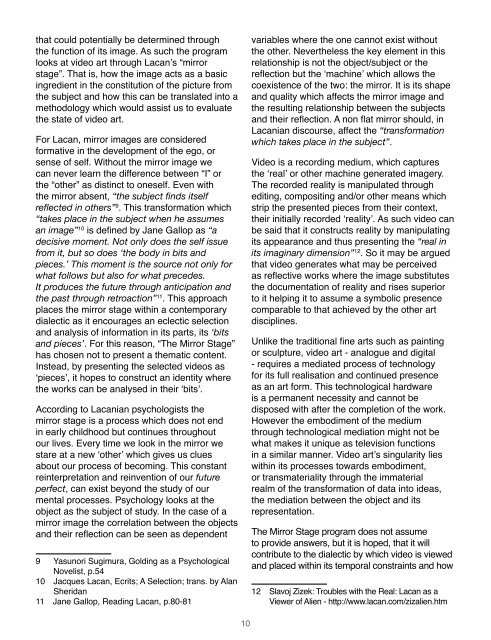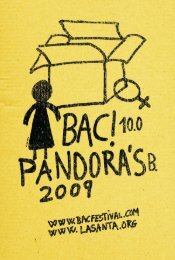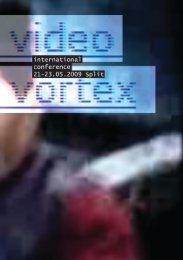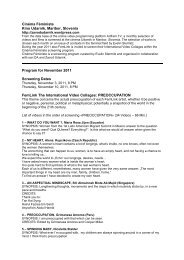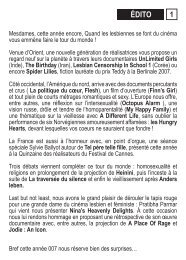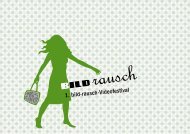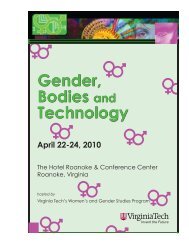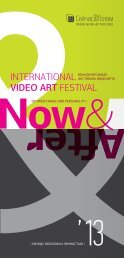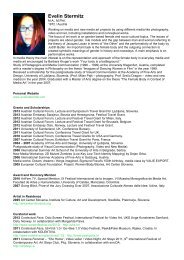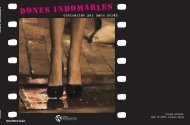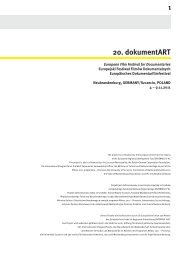catalogue - Evelin Stermitz - Mur
catalogue - Evelin Stermitz - Mur
catalogue - Evelin Stermitz - Mur
- No tags were found...
Create successful ePaper yourself
Turn your PDF publications into a flip-book with our unique Google optimized e-Paper software.
that could potentially be determined throughthe function of its image. As such the programlooks at video art through Lacan’s “mirrorstage”. That is, how the image acts as a basicingredient in the constitution of the picture fromthe subject and how this can be translated into amethodology which would assist us to evaluatethe state of video art.For Lacan, mirror images are consideredformative in the development of the ego, orsense of self. Without the mirror image wecan never learn the difference between “I” orthe “other” as distinct to oneself. Even withthe mirror absent, “the subject finds itselfreflected in others” . This transformation which“takes place in the subject when he assumesan image” 10 is defined by Jane Gallop as “adecisive moment. Not only does the self issuefrom it, but so does ‘the body in bits andpieces.’ This moment is the source not only forwhat follows but also for what precedes.It produces the future through anticipation andthe past through retroaction” 11 . This approachplaces the mirror stage within a contemporarydialectic as it encourages an eclectic selectionand analysis of information in its parts, its ‘bitsand pieces’. For this reason, “The Mirror Stage”has chosen not to present a thematic content.Instead, by presenting the selected videos as‘pieces’, it hopes to construct an identity wherethe works can be analysed in their ‘bits’.According to Lacanian psychologists themirror stage is a process which does not endin early childhood but continues throughoutour lives. Every time we look in the mirror westare at a new ‘other’ which gives us cluesabout our process of becoming. This constantreinterpretation and reinvention of our futureperfect, can exist beyond the study of ourmental processes. Psychology looks at theobject as the subject of study. In the case of amirror image the correlation between the objectsand their reflection can be seen as dependent Yasunori Sugimura, Golding as a PsychologicalNovelist, p.5410 Jacques Lacan, Ecrits; A Selection; trans. by AlanSheridan11 Jane Gallop, Reading Lacan, p.80-81variables where the one cannot exist withoutthe other. Nevertheless the key element in thisrelationship is not the object/subject or thereflection but the ‘machine’ which allows thecoexistence of the two: the mirror. It is its shapeand quality which affects the mirror image andthe resulting relationship between the subjectsand their reflection. A non flat mirror should, inLacanian discourse, affect the “transformationwhich takes place in the subject”.Video is a recording medium, which capturesthe ‘real’ or other machine generated imagery.The recorded reality is manipulated throughediting, compositing and/or other means whichstrip the presented pieces from their context,their initially recorded ‘reality’. As such video canbe said that it constructs reality by manipulatingits appearance and thus presenting the “real inits imaginary dimension” 12 . So it may be arguedthat video generates what may be perceivedas reflective works where the image substitutesthe documentation of reality and rises superiorto it helping it to assume a symbolic presencecomparable to that achieved by the other artdisciplines.Unlike the traditional fine arts such as paintingor sculpture, video art - analogue and digital- requires a mediated process of technologyfor its full realisation and continued presenceas an art form. This technological hardwareis a permanent necessity and cannot bedisposed with after the completion of the work.However the embodiment of the mediumthrough technological mediation might not bewhat makes it unique as television functionsin a similar manner. Video art’s singularity lieswithin its processes towards embodiment,or transmateriality through the immaterialrealm of the transformation of data into ideas,the mediation between the object and itsrepresentation.The Mirror Stage program does not assumeto provide answers, but it is hoped, that it willcontribute to the dialectic by which video is viewedand placed within its temporal constraints and how12 Slavoj Zizek: Troubles with the Real: Lacan as aViewer of Alien - http://www.lacan.com/zizalien.htm10


